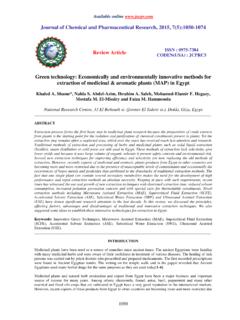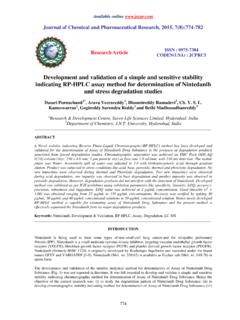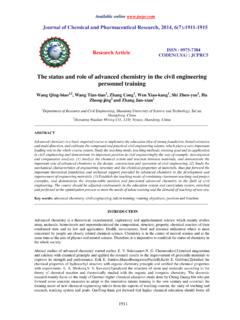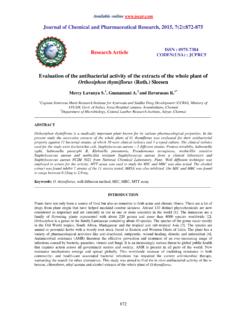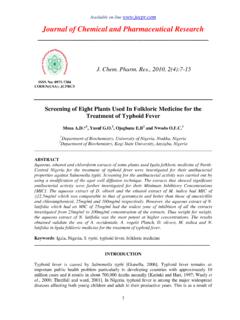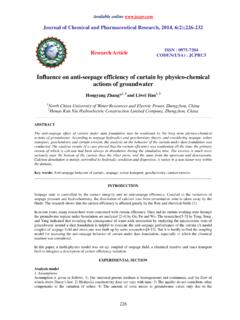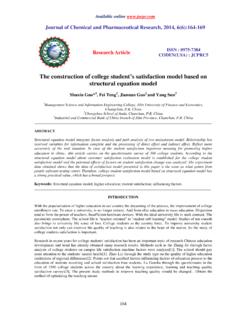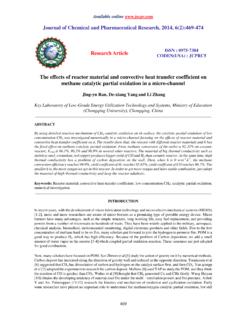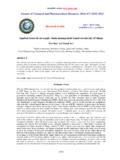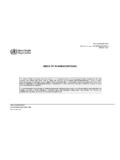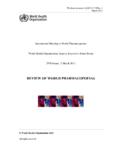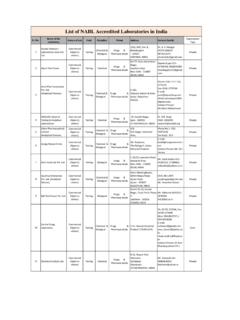Transcription of Determination of soluble extractives and physico …
1 Available online Journal of Chemical and Pharmaceutical Research, 2015, 7(8):657-660 Research Article ISSN : 0975-7384 CODEN(USA) : JCPRC5 657 Determination of soluble extractives and physico -chemical studies of bark of Sesbania sesban (L) Merr. R. K. Chaudhari1* and N. O. Girase2 1 Department of Chemistry, s Dadasaheb Rawal College, Dondaicha (Dhule), North Maharashtra University, Jalgaon, Maharashtra, India s Dadasaheb Rawal College, Dondaicha (Dhule), North Maharashtra University, Jalgaon, Maharashtra, India _____ ABSTRACT Sesbania sesban (L) Merr. has shown potential as a multipurpose tree in agro-forestry systems. The bark of sesbania sesban has been traditionally used as astringent, in diarrhea, ulcers, bronchitis, tumors, cirrhoses of liver, hypertension & spleen enlargement. This plant has got good medicinal importance [1].
2 This study was intended to evaluate the physico -chemical and some pharmacognostic parameters of bark of sesbania sesban. The bark powder was studied for proximate analysis & quantitative Determination in terms of parameters such as loss on drying, total ash value, acid-insoluble ash value, water- soluble ash values & extractive values in different solvents. The pharmacognostic parameters are useful for setting standards for crude drug and help to differentiate the plant sample from the adulterants. The pharmacognostic constants for the bark of this plant & the numerical standards reported in this work could be useful for the compilation of a suitable monograph for its proper identification. Keywords: Sesbania Sesban, physico -chemical & pharmacognostic parameters. _____ INTRODUCTION In ancient times, medicinal plants have been used all over the world as unique source of medicines and may constitute the most common human use of biodiversity.
3 Medicinal properties of plants are due to the active chemical constituents present in different parts of the plant (Mitscher et al, 1980). Medicinal plants continue to be an important therapeutic aid for the ailments of humankind. The search for eternal health and longevity and for remedies to relieve pain and discomfort drove early man to explore his immediate natural surroundings and led to the use of many plants, animal products and minerals, etc. and the development of a variety of therapeutic agents. Today, there is a renewed interest in traditional medicine and increasing demands for more drugs from plant sources. This revival of interest in plant-derived drugs is mainly due to the current widespread belief that green medicine is safe and more dependable than the costly synthetic drugs, many of which have adverse side effects.
4 Nature has bestowed upon us a very rich botanical wealth and a large number of diverse types of plants grow wild in different parts of our country. Traditionally the plant is used in the treatment of inflammatory rheumatic conditions, diarrhea, in excessive menstrual flow, to reduce enlargement of spleen and in skin diseases. has proved to be extremely popular due to its fast growth and because of its wide use as fuelwood and fodder. It has also proved to be extremely tolerant of a wide range of habitats such as saline, waterlogged etc., Being a legume, the tree fixes nitrogen and has proved R. K. Chaudhari and N. O. Girase J. Chem. Pharm. Res., 2015, 7(8):657-660 _____ 658 to be popular as a fallow species and as a agro forestry species. The leaves are compound 12-18 cm long made up of 6-27 pairs of leaflets.
5 The raceme has 2-20 flowers which are yellow with purple or brown streaks on the corolla. Pods are sub-cylindrical, straight or slightly curved up to 30 cm long and 5 mm wide containing 10- 50 seeds. The present study includes soluble extractive values and physicochemical analysis of bark of Sesbania .sesban. EXPERIMENTAL SECTION Method recommended in pharmacopoeia of India (Anonymous, 1966), and British Pharmacopoeia (Anonymous, 1973) were followed for determining ash values and percentage method. Collection and Authentication of plant Material: In the present study, the bark of Sesbania Sesban was collected from Hatti village in Dhule district. The plant material was authenticated from Mrs. J. Jayanthi, Head of the department, Botanical Survey of India, Pune. The herbarium of the voucher specimen (RKC-1) has been deposited at , Pune for future reference.
6 After authentication, the bark of sesbania sesban was air dried under shade at room temperature for 2 weeks. The dried bark material was grinded to a uniform powder and passed through sieve #40, and subjected to standardization with the different parameters. Proximate Analysis: The physico -chemical parameters are helpful in judging the purity and quality of the drug. The percentage of active principles in the plant is determined only in the dry condition. Hence, the moisture lost percentage is very important to decide about the condition of the crude drug. The moisture should be kept minimum to prevent the drug from various kinds of decomposition. The total ash and the acid insoluble ash indicate the presence of any foreign matter, inorganic composition and purity of the drug.
7 Their low value in the bark powder showed that the sample is free of any foreign matter. Loss on drying: - About 5g of drug accurately weighed in different petri dishes and kept in a hot air oven at 1100c for four hours. After cooling in a desiccators, the losses in weight are recorded in each case. This procedure is repeated till constant weight is obtained. Loss of drying (%) =Loss in weight x 100/w W=Weight of drug in gm. Ash values: - These are used to determine quality and purity of a crude drug and to establish the identity of it. Ash contains inorganic radicals like phosphates, carbonates and silicates of sodium, potassium, magnesium, calcium etc. These are present in definite amount in a particular crude drug. Hence, quantitative Determination in terms of various ash values helps in their standardization.
8 Sometimes, inorganic variables like calcium oxalate, silica, carbonate content of the crude drug affects Total ash value . Such variables are removed by treating with acid (as they are soluble in hydrochloric acid) and acid insoluble ash value is determined. These are used to determine foreign inorganic matter present as an impurity. Materials- Silica crucibles, desiccators, ash less filter paper, dilute hydrochloric acid and powdered bark of Sesbania Sesban. Determination of total ash: - 1gm of powdered drug was taken in a tarred silica crucible. The powder was then incinerated gradually by increasing the heat until free from carbon and kept for cooling. It was then kept in a desiccators , ash was weighed and % total ash was calculated with reference to the air dried sample. Determination of acid insoluble ash: - The total ash obtained after the above procedure was boiled for 5 min with 25ml of dilute hydrochloric acid.
9 It was filtered and the insoluble ash matters was collected on an ash less filter paper, washed with hot water, ignite in tarred R. K. Chaudhari and N. O. Girase J. Chem. Pharm. Res., 2015, 7(8):657-660 _____ 659 crucible, cooled and kept in a desiccators. The residue was weighed and the acid insoluble ash of bark of Sesbania Sesban was calculated with reference to the air dried drug. Determination of extractive values These are useful for the evaluation of a crude drug. Gives an idea about the nature of the chemical constituents present in the crude drug. Useful for the estimation of constituents extracted with the solvent used for extraction. Employed for material for which as yet no suitable chemical or biological assay exists. Preparations of the extracts Cold Maceration All the solvents and reagents used during study were grade.
10 Macerate 5g of the powdered crude drug of bark of sesbania sesban with each of 100ml of water, alcohol, chloroform, petroleum ether separately in a closed flask for 24 hours, shaking frequently during first 6 hours and allowing to stand for 18 hours. Filter rapidly taking precaution against loss of alcohol , evaporate 25ml of filtrate to dryness in an evaporating dish to avoid the decomposition of natural metabolites, dry at 1050c, and weigh. Calculate the percentage of water, alcohol, chloroform and petroleum ether soluble extractive value with reference to the air dried drug. The results are shown in the following table:- Table No. 1. physico -chemical parameters: Parameters evaluated Value(% w/w) Moisture content Total Ash Value Water soluble Ash value Acid-insoluble Ash value Water soluble extractive value Alcohol soluble extractive value Chloroform soluble extractive value Petroleum ether soluble extractive value Importance of extractive values: - extractive values are primarily useful for the Determination of exhausted or adulterated drugs.
